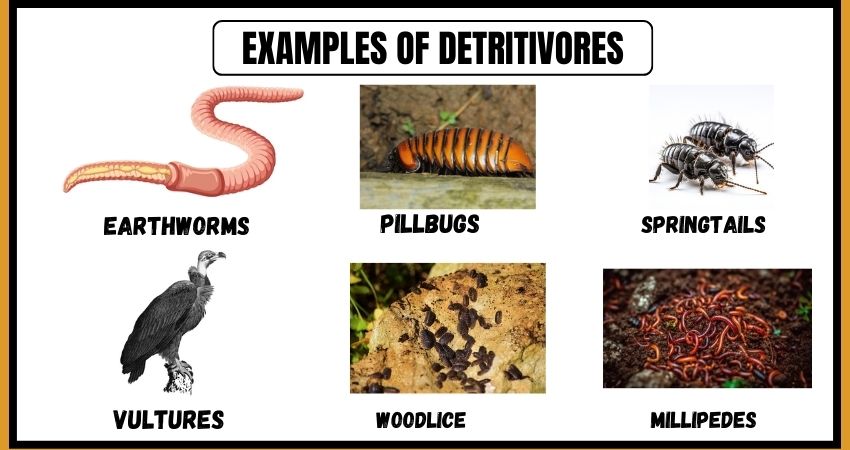Common examples of detritivores include scavengers like vultures, insects such as beetles and ants, various species of worms, and certain types of fungi.
Detritivores are organisms that play a crucial role in ecosystems by feeding on and breaking down dead and decaying organic matter. These organisms derive their nutrition from residue, which includes dead plants, animals, and other organic material. Detritivores are essential for decomposition, as they break down complex organic substances into simpler compounds. This activity not only helps to recycle nutrients back into the ecosystem but also contributes to the overall cleanliness and health of the environment.
What is an example of a Detritivore?
Certainly, here are 25 examples of detritivores, showcasing the diversity of organisms that play a vital role in breaking down and recycling organic matter in ecosystems:
Terrestrial Detritivores
Terrestrial detritivores are organisms that play a crucial role in breaking down and decomposing organic matter in terrestrial or land-based environments. These organisms contribute to the recycling of nutrients and the decomposition of dead plant and animal material, helping to maintain the health and balance of ecosystems.
Examples of Terrestrial Detritivores:
- Earthworms (Lumbricus terrestris): These segmented worms are renowned for their role in soil aeration and nutrient cycling. They consume decaying organic matter in the soil, breaking it down and enhancing soil fertility.
- Dung Beetles (Scarabaeidae): Efficient scavengers, dung beetles specialize in breaking down animal dung. By burying dung underground, they contribute to nutrient cycling and pest control in terrestrial ecosystems.
- Pillbugs (Armadillidiidae): Also known as roly-polies, these small crustaceans feed on decaying plant material, contributing to the breakdown of organic matter in terrestrial habitats.
- Springtails (Collembola): Tiny hexapods found in soil and leaf litter, springtails play a vital role in decomposing organic matter, including fungi, algae, and decaying plant material.
- Ants (Formicidae): Some ant species, such as leafcutter ants, actively participate in the decomposition process by breaking down and carrying away plant debris to their nests.
Functions of Terrestrial Detritivores:
- Decomposition: Terrestrial detritivores break down complex organic compounds into simpler forms through processes like feeding, burrowing, and excretion.
- Nutrient Recycling: By consuming and breaking down dead organic matter, these organisms release nutrients back into the soil, making them available for plants and other organisms.
- Soil Health: Terrestrial detritivores contribute to soil health by enhancing soil structure, nutrient content, and overall fertility.
- Ecosystem Balance: Their activities help prevent the accumulation of dead organic material, maintaining a balance in terrestrial ecosystems.
Aquatic Detritivores
Aquatic detritivores are organisms that play a vital role in aquatic ecosystems by feeding on and breaking down dead and decaying organic matter in water environments. These organisms contribute to the recycling of nutrients, help maintain water quality, and play a crucial role in the overall health of aquatic ecosystems.
Examples of Aquatic Detritivores:
- Sea Cucumbers (Holothuroidea): These marine invertebrates are known for their ability to consume detritus and organic matter on the ocean floor, contributing to nutrient cycling in marine ecosystems.
- Mussels (Bivalvia): Filter-feeding mussels extract particles and nutrients from the water, helping to purify aquatic environments and maintain water quality.
- Crayfish (Astacoidea): Aquatic scavengers, crayfish contribute to the decomposition of organic matter in freshwater habitats, playing a role in nutrient cycling.
- Water Bugs (Hemiptera): Found in ponds and streams, water bugs are efficient consumers of detritus, contributing to the breakdown of organic matter in aquatic ecosystems.
- Catfish (Siluriformes): Certain detritivorous catfish species, such as plecostomus, help keep aquariums and freshwater systems clean by consuming organic debris.
Functions of Aquatic Detritivores:
- Decomposition: Aquatic detritivores break down complex organic compounds in water environments, aiding in the decomposition process.
- Nutrient Cycling: By consuming detritus, these organisms release nutrients back into the water, supporting the growth of algae and other aquatic plants.
- Water Purification: Filter-feeding detritivores, like mussels, contribute to water purification by removing particles and impurities from the water column.
- Aquatic Habitat Maintenance: The activities of detritivores help prevent the accumulation of dead organic material, maintaining a healthy balance in aquatic ecosystems.
Other Detritivores:
- Vultures (Accipitridae): Scavenging birds that play a crucial role in cleaning up carrion in terrestrial ecosystems.
- Fungi (Various species): Decomposer fungi, such as saprophytic mushrooms, break down dead organic matter in diverse environments.
- Snails (Gastropoda): Some snail species feed on decaying plant material, contributing to nutrient cycling in terrestrial and aquatic habitats.
- Woodlice (Isopoda): These crustaceans are efficient decomposers of dead plant material in forest ecosystems.
- Millipedes (Diplopoda): With multiple legs and a taste for decaying plant matter, millipedes are important contributors to nutrient cycling.
- Slugs (Gastropoda): Certain slug species are detritivores, feeding on dead plant material and contributing to decomposition.
- Beetles (Various families): Many beetle species, such as burying beetles, contribute to the breakdown of animal carcasses.
- Termites (Isoptera): Detritivorous insects that play a crucial role in decomposing wood and plant material.
- Cockroaches (Blattodea): Some cockroach species act as detritivores, feeding on decaying organic matter.
- Springtails (Entomobryomorpha): Small hexapods that contribute to the breakdown of plant material in various environments.
- Harvestmen (Opiliones): These arachnids are known to feed on dead insects and plant material.
- Amphipods (Amphipoda): Aquatic detritivores found in marine and freshwater habitats, contributing to nutrient cycling.
- Rotifers (Rotifera): Microscopic detritivores found in aquatic environments, playing a role in nutrient cycling.
- Nematodes (Nematoda): Small roundworms that feed on decaying organic matter in soil and water.
- Spring Peepers (Pseudacris crucifer): These small amphibians consume a variety of invertebrates, contributing to nutrient cycling in aquatic ecosystems.
Detritivores are essential for maintaining the balance of ecosystems, promoting nutrient cycling, and contributing to the overall health of the environment.

